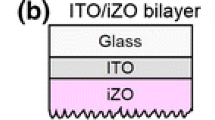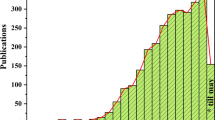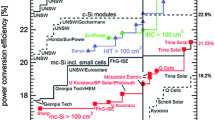Abstract
Transparent conducting oxides (TCOs) are enormously endorsed as electrodes in solar photovoltaics industry due to featuring excellent opto-electronics properties. Indium tin oxide (ITO) has been quite popular in TCO industry as it features superior electrical conductivity along with higher optical transparency in comparison with other popular TCO materials. Nevertheless, the usage of ITO has been found to be limited as front electrodes in thin film silicon solar cells due to its sustainability issue in H2 plasma and less abundance of indium. In contrast, other promising TCO materials such as aluminium doped zinc oxide (AZO), boron doped zinc oxide (BZO), gallium doped zinc oxide (GZO) etc. are found to quite durable in H2 plasma environment and relatively cost-effective too. However, the opto-electronic qualities of such films are generally inferior to the ITO films. As a result, in this contribution, a thorough study has been carried out on relatively less explored ITO/AZO bilayer TCO films. A detailed comparison in terms of the structural, morphological and opto-electronic properties among single layer ITO films, single layer AZO films and ITO/AZO bilayer films has been made. The study has been further extended to realize the impact of using ITO/AZO bilayer films instead of single layer AZO film as front electrodes in single junction a-Si:H solar cells. The best single junction a-Si:H solar cell which featured ITO/AZO bilayer as front electrode and was fabricated into superstrate configuration demonstrated significant gain in short-circuit current density (Jsc) of 0.79 mA/cm2 and hence, power conversion efficiency of 0.37% (absolute) compared to the cells which comprised of single layer 900 nm thick AZO film as front electrode (reference cell). The improvement in Jsc might be attributed to the realization of superior figure of merit (FOM) of bilayer samples to its counterpart.










Similar content being viewed by others
Data availability
The datasets generated during the study and analyses are not publicly available before publication of the manuscript as those data sets has been used to prepare the manuscript and available in the manuscript itself.
References
F.U. Hamelmann, Transparent conductive oxides in thin film photovoltaics. J. Phys. Conf. Ser. (2014). https://doi.org/10.1088/1742-6576/559/1/012016
T. Söderström, D. Dominé, A. Feltrin, M. Despeisse, F. Meillaud, G. Bugnon, M. Boccard, P. Cuony, F.-J. Haug, S. Faÿ, S. Nicolay, C. Ballif, ZnO Transparent conductive oxide for thin film silicon solar cells, proceedings of SPIE - the international society for optical engineering, 2010, https://doi.org/10.1117/12.843511
J. Hotovy, J. Hüpkes, W. Böttler, E. Marins, L. Spiess, T. Kups, V. Smirnov, I. Hotovy, J. Kovác, Sputtered ITO for application in thin-film silicon solar cells: relationship between structural and electrical properties. Appl. Surf. Sci. 269, 81–87 (2013). https://doi.org/10.1016/j.apsusc.2012.10.180
A.H. Tuan, Y. Kim, Y.-J. Lee, S.Q. Hussain, C.P.T. Nguyen, J. Lee, J. Yi, On the origin of the changes in the optoelectrical properties of boron-doped zinc oxide films after plasma surface treatment for thin-film silicon solar cell applications. Appl. Surf. Sci. 433, 798–805 (2018). https://doi.org/10.1016/j.apsusc.2017.09.254
K. Bädeker, Annalen Der Physik 22, 749–766 (1907)
G. Rupprecht, Untersuchungen der elektrischen und lichtelektrischen Leitfähigkeit dünner Indiumoxydschichten. Z. Physik 139(5), 504–517 (1954). https://doi.org/10.1007/BF01374559
S.-Y. Lien, Characterization and optimisation of ITO thin films for application in heterojunction silicon solar cells. Thin Solid Films (2010). https://doi.org/10.1016/j.tsf.2010.03.023
B.H. Lee, I.G. Kim, S.W. Cho, S.-H. Lee, Effect of process parameters on the characteristics of indium tin oxide thin film for flat panel display application. Thin Solid Films 302, 1–2 (1997). https://doi.org/10.1016/S0040-6090(96)09581-8
M.H. Ahn, E.S. Cho, S.J. Kwon, Characteristics of ITO-resistive touch film deposited on a PET substrate by in-line DC magnetron sputtering. Vacuum 101, 221–227 (2014)
Y.-H. Tak, K.-B. Kim, H.-G. Park, K.-H. Lee, J.-R. Lee, Criteria for ITO (indium-tin-oxide) thin films as the bottom electrode of an organic light emitting diode. Thin Solid Films. 411(1), 12–16 (2002). https://doi.org/10.1016/S0040-6090(02)00165-7
N. Kamanina, A. Toikka, I. Gladysheva, ITO conducting coatings properties improvement via nanotechnology approach. Nano Express (2021). https://doi.org/10.1088/2632-959X/abd90c
A. Toikka, N.V. Kamanina, Laser-vacuum deposited ITO thin films for optoelectronic applications. Sustain. Future Technol. Dev. (2021). https://doi.org/10.47577/technium.v3i7.4594
A. Toikka, N.V. Kamanina, The control of ITO conductive coating relief via laser-oriented deposited carbon nanotubes. J. Adv. Mater. Technol. (2022). https://doi.org/10.17277/jamt.2022.01.pp.058-067
A. Sharmin, S. Tabassum, M.S. Bashar, Z.H. Mahmood, Depositions and characterization of sol–gel processed Al-doped ZnO (AZO) as transparent conducting oxide (TCO) for solar cell applications. J. Theor. Appl. Phys. 13, 123–132 (2019). https://doi.org/10.1007/s40094-019-0329-0
Y. Ammaih, A. Lfakir, B. Hartiti, A. Ridah, P. Thevenin, M. Siadat, Structural, optical and electrical properties of ZnO:Al thin films for optoelectronic applications. Opt. Quant. Electron. 46, 229–234 (2014). https://doi.org/10.1007/s/1082-013-9757-2
A. Bhattacharjee, Structural, electrical and optical studies on spray-deposited aluminium doped ZnO thin films. PRAMANA J. Phys. 76, 155–163 (2011). https://doi.org/10.1007/s12043-011-0021-7
S. Bose, R. Arokiyadoss, P.B. Bhargav, G. Ahmad, S. Mandal, A.K. Barua, S. Mukhopadhyay, Modification of surface morphology of sputtered AZO films with the variation of the oxygen. Mater. Sci. Semiconduct. Process. 79, 135–143 (2018). https://doi.org/10.1016/j.mssp.2018.01.027
S. Sutthana, N. Hongsith, S. Choopun, AZO/Ag/AZO multilayer films prepared by DC magnetron sputtering for dye-sensitized solar cell application. Curr. Appl. Phys. 10, 813–816 (2010). https://doi.org/10.1016/j.cap.2009.09.020
M. Thewing, M. Veshe, K.V. Maydell, C. Agert, AZO–Ag–AZO transparent electrode for amorphous silicon solar cells. Thin Soild Films 558, 294–297 (2014). https://doi.org/10.1016/j.tsf.2014.02.042
C. Guilleˊn and, TCO/metal/TCO structures for energy and flexible electronics. Thin Solid Films. 520, 1–17 (2011). https://doi.org/10.1016/j.tsf.2011.06.091
H.J. Park, J.H. Park, J.I. Choi, J.Y. Lee, J.H. Chae, D. Kim, Fabrication of transparent conductive films with a sandwich structure composed of ITO/Cu/ITO. Vacuum. 83, 448–450 (2009). https://doi.org/10.1016/j.vacuum.2008.04.061
S. Eckhardt, T. Roch, C. Sachse, A.F. Lasagni, Light management of aluminium doped zinc oxide thin films by fabricating periodic surface textures using direct laser interference patterning. Adv. Eng. Mater. 15(10), 940–947 (2013). https://doi.org/10.1002/adem.201300007
C. Wang, Y. Mao, X. Zeng, Properties of ITO–AZO bilayer thin films prepared by magnetron sputtering for applications in thin-film silicon solar cells. Appl. Phys. A 110, 41–45 (2013). https://doi.org/10.1007/s00339-012-7431-3
X. Shen, M. Yang, C. Zhang, Z. Qiao, H. Wang, C. Tang, Utilising magnetron sputtered AZO–ITO bilayer structure as transparent conducting oxide for improving the performance of flexible CIGS solar cell. Superlattices Microstruct. 123, 251–256 (2018). https://doi.org/10.1016/j-spmi.2018.09.001
J.J. Kim, J.H. Park, J. Yoo, Y.S. Cho, J.-S. Cho, Fabrication of surface-textured ZnO:Al/ ITO bilayers with enhanced electrical and light-scattering properties. Solid State Sci. 31, 75–80 (2014). https://doi.org/10.1016/j.solidstatesciences.2014.03.003
Q.J. Jiang, J.G. Lu, Y.L. Yuan, H. Cai, J. Zhang, N. Deng, Z.Z. Ye, Enhancement of the light trapping by double-layered surface texture of ITO/AZO and AZO/AZO transparent conductive films. Mater. Lett. 123, 14–18 (2014). https://doi.org/10.1016/j.matlet.2014.02.074
X.-Y. Li, H.-J. Li, Z.-J. Wang, H. Xia, Z.-Y. Xiong, J.-X. Wang, B.-C. Yang, Effect of substrate temperature on the structural and optical properties of ZnO and Al-doped ZnO thin films prepared by dc magnetron sputtering. Opt. Commun. 282(2), 247–252 (2009). https://doi.org/10.1016/j.optcom.2008.10.003
A.H. Ali, Z. Hassan, A. Shuhaimi, Enhancement of optical transmittance and electrical resistivity of post-annealed ITO thin films RF sputtered on Si. Appl. Surf. Sci. 443, 544–547 (2018). https://doi.org/10.1016/j.apsusc.2018.03.024
G. Fang, D. Li, B.-L. Yao, Fabrication and characterization of transparent conductive ZnO:Al thin films prepared by direct current magnetron sputtering with highly conductive ZnO(ZnAl2O4) ceramic target. J. Cryst. Growth. 247, 3–4 (2003). https://doi.org/10.1016/S0022-0248(02)02012-2
G. Haacke, New figure of merit for transparent conductors. J. Appl. Phys. 47, 4086–4089 (1976). https://doi.org/10.1063/1.323240
S. Bose, S. Mandal, A.K. Baruaand, Properties of boron doped ZnO films prepared by reactive sputtering method: application to amorphous silicon thin film solar cells. J. Mater. Sci. Technol. 55, 136–143 (2020). https://doi.org/10.1016/j.jmst.2019.12.004
M.N. Rezaie, N. Manavizadeh, E.M.N. Abadi, E. Nadimi, F.A. Boroumand, Comparison study of transparent RF-sputtered ITO/AZO and ITO/ZnO bilayers for near UV-OLED applications. Appl. Surf. Sci. 392, 549–556 (2017). https://doi.org/10.1016/j.apsusc.2016.09.080
W.-T. Hsiao, S.-F. Tseng, K.-C. Huang, D. Chiang, Electrode patterning and annealing processes of aluminum-doped zinc oxide thin films using a UV laser system. Opt. Lasers Eng. 51(1), 15–22 (2013). https://doi.org/10.1016/j.optlaseng.2012.08.003
S.O. El hamali, W.M. Cranton, N. Kalfagiannis, X. Hou, R. Ranson, D.C. Koutsogeorgis, Enhanced electrical and optical properties of room temperature deposited aluminium doped Zinc Oxide (AZO) thin films by excimer laser annealing. Opt. Lasers Eng. 80, 45–51 (2016). https://doi.org/10.1016/j.optlaseng.2015.12.010
M. Acosta, J. Mendez-Gamboa, I. Riech, C. Acosta, M. Zambrano, AZO/Ag/AZO multilayers electrodes evaluated using a photonic flux density figure of merit for solar cells applications. Superlattices Microstruct. 127, 49–53 (2019). https://doi.org/10.1016/j.spmi.2018.03.018
M. Mohamedi, F. Challali, T. Touam, Ag thickness and substrate effects on microstructural and optoelectronic properties of AZO/Ag/AZO multilayer structures deposited by confocal RF magnetron sputtering. Appl. Phys. A (2023). https://doi.org/10.1007/s00339-023-06822-8
D. Mendil, F. Challali, T. Touam, V. Bockelée, S. Ouhenia, A. Souici, D. Djouadi, A. Chelouche, Preparation of RF sputtered AZO/Cu/AZO multilayer films and the investigation of Cu thickness and substrate effects on their microstructural and optoelectronic properties. J. Alloys Compd. (2021). https://doi.org/10.1016/j.jallcom.2020.158470
Funding
The present work has been carried out in DST-IIEST Solar PV Hub and supported by Department of Science and Technology (DST/TMD/SERI/HUB/2(G) Govt. of India (GoI). One of the authors Dibyendu Kumar Ghosh is acknowledging Ministry of New and Renewable Energy (MNRE), India for their financial support for carrying out his doctoral studies.
Author information
Authors and Affiliations
Contributions
All authors contributed to the conception, design and execution. DKG: film deposition and analysis, preparing manuscript, SB: preparing manuscript, GD: conceptualizing and cell fabrication, SM: proof correction and supervising, AS: supervising and mentor. All authors read and approved the final manuscript.
Corresponding author
Ethics declarations
Conflict of interest
The authors have no relevant financial or non-financial interests to disclose.
Additional information
Publisher’s Note
Springer Nature remains neutral with regard to jurisdictional claims in published maps and institutional affiliations.
Rights and permissions
Springer Nature or its licensor (e.g. a society or other partner) holds exclusive rights to this article under a publishing agreement with the author(s) or other rightsholder(s); author self-archiving of the accepted manuscript version of this article is solely governed by the terms of such publishing agreement and applicable law.
About this article
Cite this article
Ghosh, D.K., Bose, S., Das, G. et al. Realization of performance enhancement of thin film silicon solar cells by applying ITO/AZO bilayer TCO films as front electrode. J Mater Sci: Mater Electron 34, 2189 (2023). https://doi.org/10.1007/s10854-023-11570-9
Received:
Accepted:
Published:
DOI: https://doi.org/10.1007/s10854-023-11570-9




